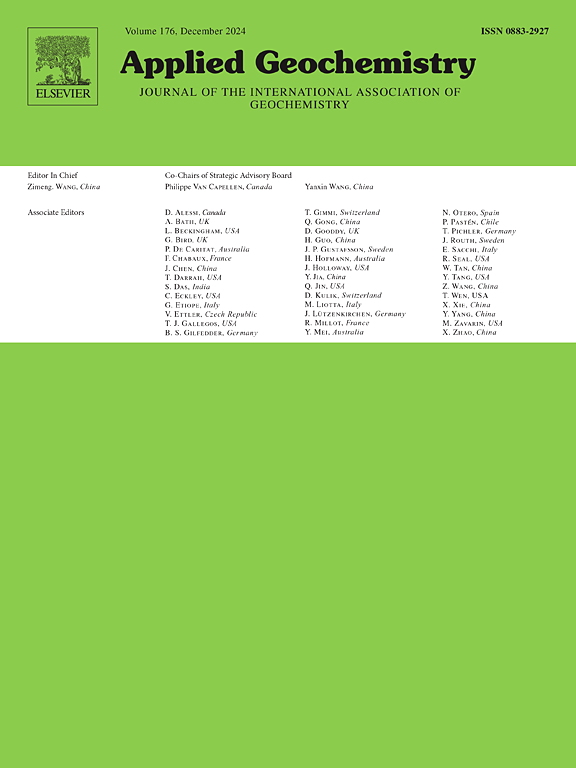Evaluating the applicability of the VERHIB model to a 2600-year peat sequence from Central Germany
IF 3.1
3区 地球科学
Q1 GEOCHEMISTRY & GEOPHYSICS
引用次数: 0
Abstract
Plant-derived biomarkers have been used extensively for source identification of organic matter in soil, peat, and sediments. These are chemical components, primarily of leaf waxes, that are naturally more resistant to degradation than most organic molecules and can be preserved in depositional archives for hundreds to thousands of years. However, using biomarkers for vegetation reconstruction can be complicated because individual compounds or compound classes do not necessarily indicate specific plant sources. The composition across multiple compounds must be holistically evaluated to develop accurate reconstructions. The VERHIB model was developed to enable a range of n-alkane and n-alkanol data to be evaluated simultaneously and estimate past vegetation development using the biomarker signature of leaves and roots from present-day specimens of the plant species of interest compared to the preserved, mixed signature of a soil or peat core. In this study, we have applied the VERHIB model to data gathered from the Beerberg peatland in Central Germany. A previous study characterized plant macrofossils, pollen, n-alkane, n-alkanol, and n-fatty acid composition in the Beerberg peat. We have collected modern plant samples from the peatland and measured their biomarker composition to use as input for the model. Despite many overlapping biomarker signatures across plant species and parts, our results show that the model could recreate a reasonable vegetation development pattern for most of the peat core if n-fatty acid data were included alongside n-alkane data. The model had difficulty recreating the transition from poor fen vegetation to Sphagnum bog, which was evident in the plant macrofossil records, so further calibration is needed. This was the first attempt at considering n-fatty acid data in a reconstruction using the VERHIB model; previous reconstructions only included n-alkanes or a combination of n-alkanes and n-alkanols. Our study shows that n-fatty acids are a valuable compound class to add to the VERHIB model and provides recommendations for future development.
评估VERHIB模型对德国中部2600年泥炭序列的适用性
植物来源的生物标志物已广泛用于土壤、泥炭和沉积物中有机质的来源鉴定。这些是化学成分,主要是叶蜡,天然比大多数有机分子更耐降解,可以在沉积档案中保存数百年至数千年。然而,使用生物标志物进行植被重建可能会很复杂,因为单个化合物或化合物类别不一定表明特定的植物来源。跨多个化合物的组成必须进行整体评估,以开发准确的重建。VERHIB模型的开发是为了能够同时评估一系列正烷烃和正烷醇数据,并使用来自感兴趣的植物物种的现代标本的叶子和根的生物标志物特征与保存的土壤或泥炭核心的混合特征进行比较,来估计过去的植被发育。在这项研究中,我们将VERHIB模型应用于德国中部贝尔贝格泥炭地收集的数据。先前的研究对Beerberg泥炭中的植物大化石、花粉、正烷、正烷醇和正脂肪酸组成进行了研究。我们从泥炭地收集了现代植物样本,并测量了它们的生物标志物组成,作为模型的输入。尽管植物物种和部分之间存在许多重叠的生物标志物特征,但我们的研究结果表明,如果将正脂肪酸数据与正烷烃数据一起包括在内,该模型可以重建大多数泥炭岩心的合理植被发育模式。该模型难以重现从贫瘠的沼泽植被到泥炭沼泽的过渡,这在植物大化石记录中很明显,因此需要进一步校准。这是使用VERHIB模型在重建中考虑n脂肪酸数据的第一次尝试;以前的重建只包括正构烷烃或正构烷烃和正烷醇的组合。我们的研究表明,n脂肪酸是一个有价值的化合物类别,可以添加到VERHIB模型中,并为未来的发展提供建议。
本文章由计算机程序翻译,如有差异,请以英文原文为准。
求助全文
约1分钟内获得全文
求助全文
来源期刊

Applied Geochemistry
地学-地球化学与地球物理
CiteScore
6.10
自引率
8.80%
发文量
272
审稿时长
65 days
期刊介绍:
Applied Geochemistry is an international journal devoted to publication of original research papers, rapid research communications and selected review papers in geochemistry and urban geochemistry which have some practical application to an aspect of human endeavour, such as the preservation of the environment, health, waste disposal and the search for resources. Papers on applications of inorganic, organic and isotope geochemistry and geochemical processes are therefore welcome provided they meet the main criterion. Spatial and temporal monitoring case studies are only of interest to our international readership if they present new ideas of broad application.
Topics covered include: (1) Environmental geochemistry (including natural and anthropogenic aspects, and protection and remediation strategies); (2) Hydrogeochemistry (surface and groundwater); (3) Medical (urban) geochemistry; (4) The search for energy resources (in particular unconventional oil and gas or emerging metal resources); (5) Energy exploitation (in particular geothermal energy and CCS); (6) Upgrading of energy and mineral resources where there is a direct geochemical application; and (7) Waste disposal, including nuclear waste disposal.
 求助内容:
求助内容: 应助结果提醒方式:
应助结果提醒方式:


